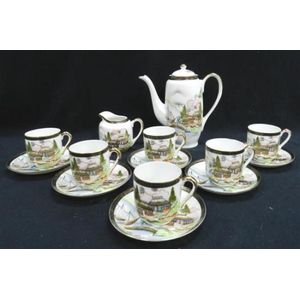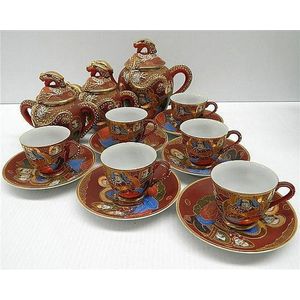
German Regimental Porcelain Beer Steins, 1930s
Three German porcelain regimental beer Steins, circa 1930s, the three reproduction regimental pre-World War I steins with tapered bodies, curved handles, pewter lids, lithophane in the base depicting soldier and sweetheart, lion and eagle thumb lifts,…

Kutani Geisha Lithophane Porcelain Tea Set
A Kutani 'Geisha Girl' lithophane porcelain tea set, circa 1950s, maker's stamp of Haysai, the egg shell porcelain service comprising teapot, creamer, covered sugar bowl and twelve cups with associated saucers, all decorated in a refined grisaille palette…

Japanese Handpainted Tea Set with Geisha Lithophane
A Japanese export ware porcelain tea service with handpainted rural scenes and a Lithophane of a Geisha's face, includes a teapot, creamer, six cups and saucers

Showa Period Porcelain Dinner Service with Lithophane and Pine
A one hundred piece porcelain dinner service, a Lithophane in the bottom of each cup, Japan, Showa period painted with a pine tree, includes fourteen dinner plates, entree plates, side plates, soup bowls, dessert bowls, cups and saucers, and two large…

Dresden Dancing Lamp with Lithophane Shade
Dresden 'Ring Around the Rosie' lamp modelled with four young adults dancing around a tree form body, on a floral applied ground, all on a scrolled floral base, having a four lithophane panelled shade, decorated with gold accents & flowers, with a flower…

Dresden Dancing Lithophane Lamp
Dresden 'Ring Around the Rosie' lamp modelled with four young adults dancing around a tree form body, on a floral applied ground, all on a srcolled flroral base, having a four lithophane panelled shade, decorated with gold accents & flowers, with a flower…

Satsuma Lithophane Geisha Tea Set
Twentieth century Satsuma lithophane tea set, teapot measuring 15 cm tall. 11 cup and saucers with lithophane depicting Geisha head

KPM Lithophane of 'Laura' in Fine Quality Frame
A framed fine quality KPM lithophane with an image of 'Laura'. Sceptre mark & KPM and 285

Lithophane Pressed Images of Historical Scenes
Two lithophane style pressed images of 'Mary Queen of Scots Receiving Warrant for Execution' and of 'Queen Elizabeth Smiting Earl of Essex', 39 x 29 cm including frame

Dresden Electric Lamp with Ornate Porcelain Shade
A good vintage Dresden electric lamp, base with figures of 5 children hand in hand and ornate pierced porcelain shade, with four lithophane panels, two light globe fittings, 43 cm high approx.

Mid-century Chinese lithophane geisha porcelain tea set
A Chinese mid 20th century lithophane geisha 'An hua' porcelain tea set

 Loading more...
Loading more...